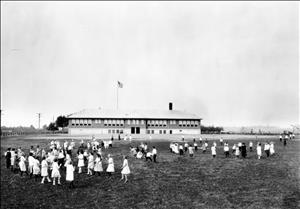This history of Crown Hill School is taken from the second edition of Building for Learning: Seattle Public School Histories, which includes histories of every school building used by the district since its formation around 1862. The original essay was written for the 2002 first edition by Nile Thompson and Carolyn J. Marr, and updated for the 2024 edition by HistoryLink contributor Casey McNerthney.
Crown Hill School
Residents of the developing Crown Hill neighborhood north of Ballard found themselves in a predicament in 1908 when it came to sending their children to school. Because they lived north of the city limits at 85th Street, their neighborhood school was considered Oak Lake, a walk of several miles to the northeast. If they were willing to pay tuition, their children could walk two miles south to Whittier. When Greenwood School opened in 1909, it offered them another choice within Seattle Public Schools, but still at a fee. Eventually Crown Hill parents convinced the school board to add a square mile of their neighborhood to the service area of Whittier so these children could attend without tuition.
By fall 1916, Whittier was bursting at the seams. Even with nine portables, the school had to go onto a platoon system in which pupils split into groups and participated in classes on a rotating basis, resulting in longer school days with periods of exercise and vocational work. This further fueled Crown Hill parents’ longing for their own school. Albert Lundberg, on behalf of Crown Hill residents, persuaded the school board in 1918 to purchase a site and build a school. The site chosen by the board was outside Seattle in unincorporated King County. Designing Crown Hill School, the architect decided on a smaller six-classroom building because the population did not seem to warrant construction of the district’s standard nine-room structure. The design was simple and functional, but eventually its small size was a limitation.
Crown Hill opened one spring afternoon in 1919 with a march of children in grades 2-4 from Whittier School. Other students transferred in from Greenwood School. The following September it was expanded to grades 1-6. A double portable was added as a lunchroom in 1925. Early fare consisted of soup and cocoa served by mothers from the PTA. Kindergarten was added in September 1936. Portables appeared by 1941-1942 when one was moved midyear from Ballard High School. Crown Hill did not become an independent school until 1942, when enrollment climbed to 309, well over the 280-student minimum.
Post-war Growth and Decline
An addition of seven classrooms, a kindergarten, gymnasium, auditorium/lunchroom, and offices, in an L-shaped structure fronting on 14th Avenue NW and NW 95th Street was opened in 1949 to handle the anticipated increase in post-war enrollment. Enrollment was vastly underestimated, and a dramatic increase of students from 397 in 1947-1948 to 901 in 1957-1958 required the use of 10 portables. A portable annex to Crown Hill called Northwest Elementary opened in 1953-1954 and was used for two years to relieve enrollment pressure at Crown Hill. Northwest Elementary was the original name of the school that would become North Beach School, opened in 1958. A school library was established in 1958-1959 with more than 5,000 books.
Over the next several years, enrollment at Crown Hill School started to decline. Three portables were removed by 1959-1960. Enrollment was at 511 for 1966-1967. In 1973, the school boundary line was adjusted nearer to the school, resulting in 45 students being transferred to North Beach and only 300 students remaining at Crown Hill. In 1979, as part of the district’s long-range plans for consolidation, Crown Hill was one of several schools slated for closure. A group of parents presented a plan to establish a K-8 facility at Whitman in order to keep their students together, but their proposal was voted down by the board 4-3, and the students were transferred to North Beach, Viewlands, and Greenwood.
The buildings were leased out by the school district beginning in 1980. The original 1919 building was renovated in 1989, moving the kitchen downstairs into what was once the coal-fired boiler. Tenants included Small Faces Child Development Center, Northwest Youth Services, and the Phinney Neighborhood Association. Small Faces became the master tenant and took over maintenance and rental space on behalf of Seattle Public Schools, which for a time became a subtenant. In addition to being home to Small Faces, the site was providing spaces for sports, community meetings, the ARC School of Ballet and other dance classes in 2007. That year, an effort started between some school district leaders, city officials, and Small Faces staff to transfer ownership of the building at fair market value. In summer 2009, after years of negotiations, the school district completed sale of the building to Small Faces, which was helped by a $908,000 state grant and additional funding by the City of Seattle. In 2008, the district sold the 1.7-acre playfield to Seattle Parks for the creation of Crown Hill Park, which now features a playground, ballfield, and skate park.
History
Crown Hill School
Location: 9250 14th Avenue NW
Building: 6-room, 1-story stucco
Architect: Edgar Blair
Site: 5 acres
1918: Named on November 7
1919: Opened in spring as annex to Whittier
1942: Became independent in September
1949: Addition (Bebb & Jones)
1979: Closed in June
1981-82: Leased
2008: Playfield sold to Seattle Parks
2009: Building sold to Small Faces Child Development Center

